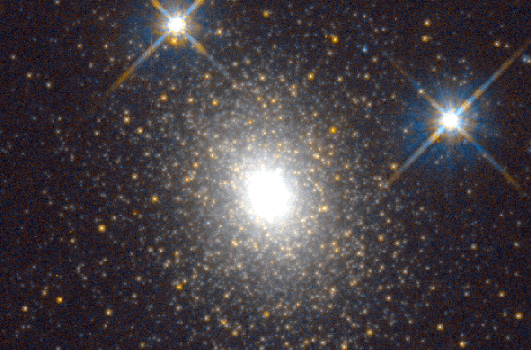Astronomy Picture of the Day
Discover the cosmos!
Each day a different image or photograph of our fascinating universe is
featured, along with a brief explanation written by a professional
astronomer.
April 26, 1996

A Giant Globular Cluster in M31
Credit:
Michael Rich, Kenneth Mighell, and James D. Neill
(Columbia
University), and Wendy Freedman (Carnegie
Observatories),
Hubble Space Telescope, and
NASA
Explanation:
G1, pictured above, is the brightest known
globular cluster in the whole
Local Group of galaxies. Also called Mayall II,
it orbits the center of the largest nearby galaxy:
M31.
G1 contains over 300,000 stars and is almost as
old as the entire universe.
In fact, observations of this
globular cluster show
stars as old as the oldest of the roughly 250 known
globular clusters in our own
Milky Way Galaxy.
This image
was taken with the
Hubble Space Telescope in July of 1994.
It shows, for the first time, the same fine detail in a
distant globular cluster
as can be discerned from a ground-based telescope of a
globular cluster in
our own Galaxy.
Tomorrow's picture: Apollo 14: Rickshaw Tracks Across the Moon
| Archive
| Index
| Search
| Glossary
| Education
| About APOD |




Authors & editors:
Robert Nemiroff
(GMU) &
Jerry
Bonnell (USRA).
NASA Technical Rep.:
Sherri
Calvo.
Specific rights apply.
A service of:
LHEA
at
NASA/
GSFC




